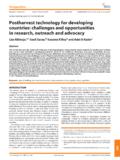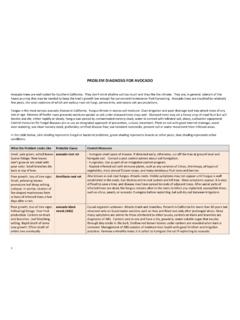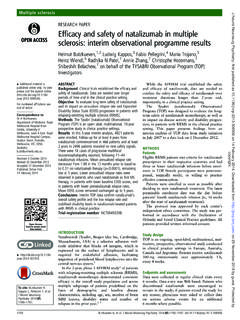Transcription of Ef®cacy of Sanitizers To Inactivate Escherichia coli O157 ...
1 2375 Journal of Food Protection, Vol. 67, No. 11, 2004, Pages 2375 2380 Efficacy of Sanitizers To InactivateEscherichia coliO157:H7 onFresh-Cut Carrot Shreds under Simulated ProcessWater Conditions ROLANDO J. GONZALEZ,1 YAGUANG LUO,2* SAUL RUIZ-CRUZ,3 ANDJAMES L. MCEVOY21 Department of Laboratory Medicine and Pathology, University of Minnesota Medical School, Minneapolis, Minnesota 55425, USA;2 Produce Qualityand safety Laboratory, Department of Agriculture Agricultural Research Service, Beltsville Agricultural Research Center, 10300 BaltimoreAvenue, Building 002, Room 117, Beltsville, Maryland 20705, USA;3 Horticultural Products and Cereal Technology, Center of Research in Food andDevelopment, , Carretera a la Victoria km , Hermosillo, Sonora 83000, MexicoMS 04-84: Received 27 February 2004/Accepted 9 June 2004 ABSTRACTC hlorine is widely used as a sanitizer to maintain the microbial quality and safety of fresh-cut produce.
2 However, chlorinetreatment lacks efficacy on pathogen reduction, especially when the fresh-cut processing water contains heavy organic more efficacious sanitizer that can tolerate the commercial processing conditions is needed to maintain microbial safety offresh-cut produce. This study evaluated the efficacy ofEscherichia coliO157:H7 reduction on fresh-cut carrots using new andtraditional Sanitizers with tap water and fresh-cut processing water scenarios. Fresh-cut carrot shreds inoculated withE. coliO157:H7 were washed in sanitizer solutions including 200 ppm chlorine, citric acid based sanitizer (Pro-San), 80 ppm per-oxyacetic acid-based sanitizer (Tsunami 100), and 1,000 ppm acidified sodium chlorite (SANOVA) prepared in fresh tap wateror simulated processing water with a chemical oxygen demand level of approximately 3,500 mg/liter.
3 Samples were packagedand stored at 58C. Microbial analyses performed at days 0, 7, and 14 indicate that the organic load in the process watersignificantly affected the efficacy of chlorine on pathogen removal and was especially evident on samples tested during sodium chlorite provided a strong pathogen reduction even under process water conditions with up to a when compared with the no-wash coliO157:H7 was not recovered on acidified sodium chlorite treatedsamples during the entire 14 days of storage, even following an enrichment step. These results suggest that acidified sodiumchlorite holds considerable promise as an alternative sanitizer of fresh-cut produce is one of the hottest growing con-venience foods in history because it offers freshness, nu-trition, and convenience(14).
4 However, contamination offresh produce with human pathogens can occur anywherein their journey from farm to table(6).Given that fresh-cut products are marketed as prewashed and ready to eat,and not subject to further microbial killing steps, the needfor effective disinfecting agents during produce washing isclearly evident to ensure product has been used widely in the fresh produceindustry as a sanitizer in wash, spray, and flume waters atconcentrations of 50 to 200 ppm (as sodium hypochlorite,NaOCl) and a contact time of up to 2 min(11, 26).How-ever, the efficacy of chlorine on pathogens is limited(7, 11,27).Chlorine also loses its activity rapidly on contact withorganic matter, increased temperature, exposure to light,and contact with metals(12).
5 The Food and Drug Administration (FDA) andEnvironmental Protection Agency (EPA) have recently ap-proved the use of acidified sodium chlorite for spray or dipsanitizing certain food products, including fruits and veg-etables, at levels of 500 to 1,200 ppm(3).Acidified sodium* Author for correspondence. Tel: 301-504-6128; Fax: 301-504-5107;E-mail: Mention of a trademark or proprietary product does not constitute aguarantee or warranty of the product by the Department of Agri-culture and does not imply its approval to the exclusion of other productsthat might also be is a combination of citric acid and sodium chloritein aqueous solution, with a mostly oxidative mode of ac-tion.
6 In a recent study, Lukasik et al.(17)found that acid-ified sodium chlorite produced the greatest reduction in thenumbers ofEscherichia coliO157:H7 andSalmonellaMontevideo from inoculated strawberries compared withchlorine, peroxyacetic acid, and stabilized chlorine (peracetic) acid is a strong oxidizingagent that has been used extensively to disinfect food pro-cessing equipment and has been approved by the FDA asa disinfectant for fruits and vegetables(2).Pilot-scale trialsundertaken to determine the suitability of peracetic acid forwashing minimally processed vegetables showed it to beeffective againstListeria monocytogenes, Salmonellaspp.,andE. coliO157:H7, achieving reductions of , ,and , respectively, at 10 ppm and as little as 30 s ofimmersion in a batch washing scheme with chilled water(22).
7 A citric acid based sanitizer also has been approvedrecently by both the EPA and FDA as a no-rinse published data is available on its sanitizer studies are conducted with pure lab wa-ter. Given that fresh-cut process water contains a large or-ganic load as a result of water reutilization, comparisons ofsanitizers in water containing organic matter is needed inorder to select the most efficacious Sanitizers that can tol-erate commercial processing conditions and maintain mi-crobial safety of fresh-cut produce. The main objective ofJ. Food Prot., Vol. 67, No. 112376 GONZALEZ ET study was to evaluate the efficacy of chlorine, citricacid, peracetic acid, and acidified sodium chlorite in reduc-ing populations ofE.
8 ColiO157:H7, total aerobic bacteria,and yeasts and molds from shredded carrots under tap waterand simulated fresh-cut wash water conditions. The role ofthese Sanitizers in maintaining the microbial safety of washwater was also AND METHODSB acterial strains and growth nalidixic acid resistant (Nalr) derivative of an outbreakE. coliO157:H7 strain(F6460) was used throughout this study. F6460 was isolated frompatient fecal samples during a 1999 Nebraska lettuce nalidixic acid resistant derivative strain, F6460 Nalr, was iso-lated as described previously(25)and stored at2808C in Luria-Bertani broth (Difco, Becton Dickinson, Sparks, Md.) containing25% (vol/vol) coliO157:H7 was grown overnight inLuria-Bertani Nal broth at 378C with constant agitation at 175rpm.
9 Cultures were mixed, washed by centrifugation (4,0003g,15 min, 48C) with peptone saline water, and added propor-tionally to tap water to obtain a dip inoculum solution with apopulation ofE. coliO157:H7 Nalrhigh enough to result in about105to 106 CFU/g on carrot shreds after inoculation, as determinedfrom unpublished preliminary carrots (Daucus carota,L.) werepurchased from a produce wholesale market (Jessup, Md.) andused within 24 h following storage at 58C. Carrots were shreddedwith a food processor (Cuisinart, East Windsor, ) and dividedinto individual 120-g portions contained in nylon mesh bags (Lin-ens N Things, Clifton, ).Procedure for inoculation, a commonlyused method in sanitizer challenge studies, was chosen to simulatethe immersion process of commercial produce washing operations(9).
10 Samples were immersed in theE. coliO157:H7 Nalrinoculumsolution (sample-inoculum51:10, wt/vol) and kept under con-stant agitation for 30 min, followed by drainage for 1 min andspin-drying in a manually actuated salad spinner (OXO GoodGrips, Elmira, ). The salad spinner was operated by pushingthe actuator 15 times at about one push per second. Samples wereremoved from the spinner after it came to a full Sanitizers , including acidifiedsodium chlorite (1,000 ppm SANOVA, Alcide Corp., Redmond,Wash.), citric acid based sanitizer (1% Pro-San, Microcide Corp.,Detroit, Mich.), and peroxyacetic acid (80 ppm Tsunami 100,Ecolab, St. Paul, Minn.), were obtained directly from the manu-facturers; the concentrations of the solutions tested were based oneach manufacturer s recommendation.



















